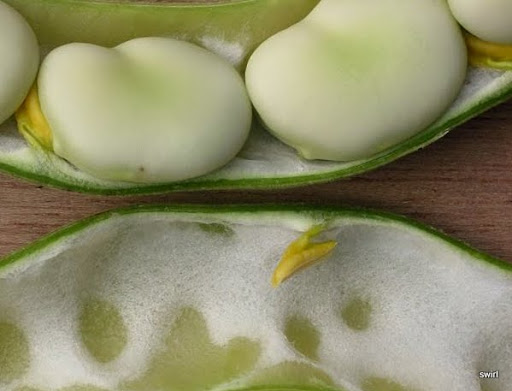Savory Bites
Beth Ribblett
Those Fleetingly Fresh Fava Beans - April is always exciting month at our Crescent City Farmers Market. The warm days and cool nights of spring in the south encourage lots of new growth at our local farms and the market has plenty to show for it. It also marks the entry of one of my most favorite spring time vegetables, fava beans. I was so excited to see those heaping baskets of beans that I quickly began to come up with a recipe based on the favas that I could cook that night using ingredients available at the market (click here for Orchietti with Fresh Fava Beans and Gulf Shrimp).
The pale green beans in the big floppy pods have been a beloved early spring food on much of the planet for centuries. Usually available here from April to early June, they have a buttery texture, slight bitterness and lovely, nutty flavor they are well worth the time it takes to remove them from their pods and outer shells.

These ancient beans, whose most common alternate name is the Broad bean, were the primary legume grown in Europe before the introduction of the of the great diversity of New World bean varieties. Because of this history, Fava recipes are primarily based on European cooking traditions. Fava beans have been found in some of the earliest-known Old World human settlements. It is currently believed that they became part of the eastern Mediterranean diet at about 6000 BC and possibly even earlier. Favas are particularly used as a staple in Italian cuisine though they are generally associated with all Mediterranean and Middle-Eastern cooking traditions. Favas also have an equally ancient association with Chinese cuisine. The most frequently heard alternate names for Fava beans are Broad beans, Windsor beans, Horse beans, and Pigeon beans.
So don't wait, get out and buy some fresh Favas! There are plenty of recipes online or you can check out mine from Saturday night, Orrechiette with Fresh Fava Beans and Gulf Shrimp. And here are the directions for prepping them so you can use them in recipes:
Before you begin to shell the beans, bring a large saucepan of water to boil. Snap the stem of each pod and use it to pull off the string that runs the length of the pod along the seam. Open the pod along this seam and brush the beans into a bowl.
Add the beans to the boiling water and cook them just until you can see a dark spot in the center of the bean's skin, about 3 minutes. Drain the beans and refresh them with cold water until they are cool enough to handle. Drain them well. With a pairing knife, pull off the dark, crescent shaped marking at the end of each bean. Squeeze the bean out through this opening. Discard the shell. The favas are now ready to eat or use in a recipe.